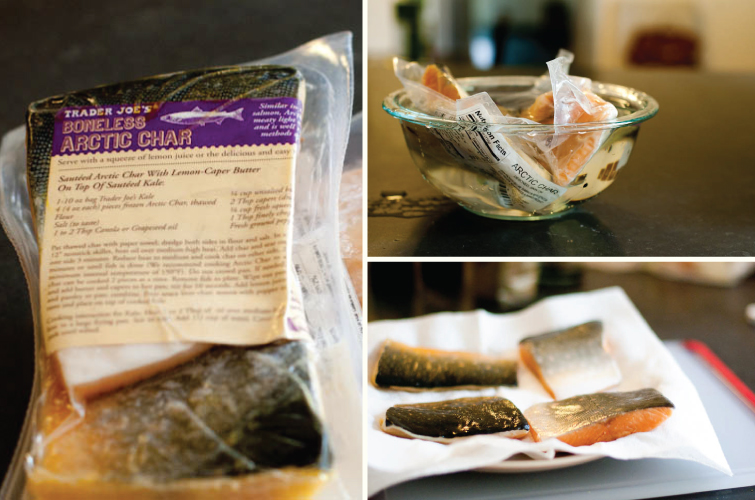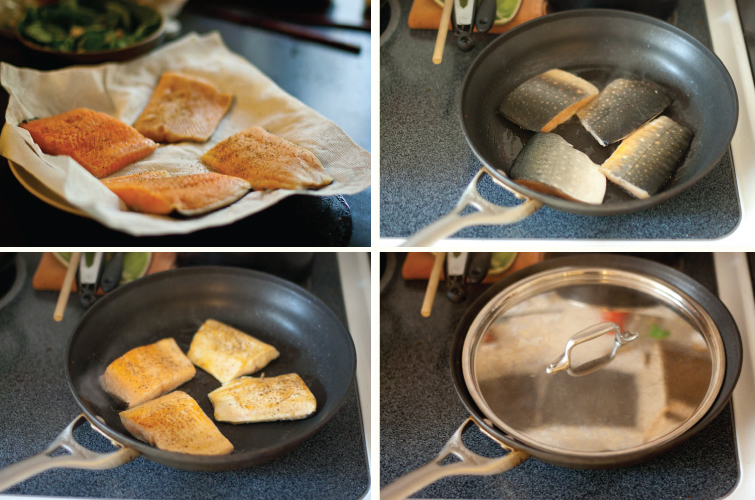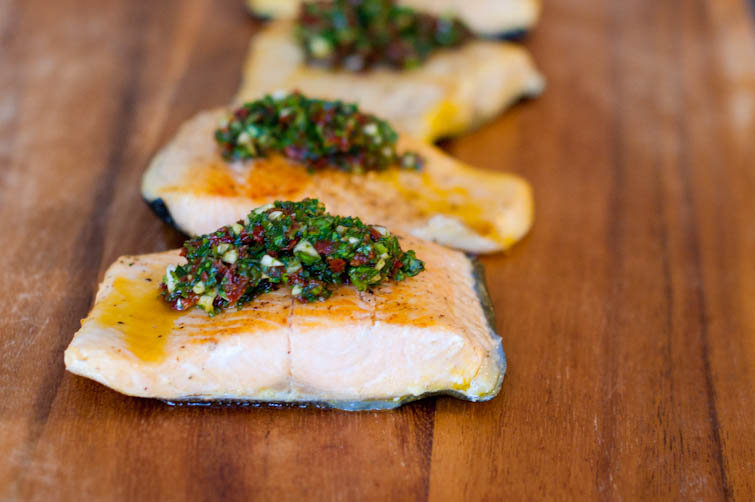How to Sear and Simmer Fish at Home
Cooking fish at home seems to scare a lot of people, and there are a whole list of excuses people employ:
- It makes the whole house smell fishy
- I don’t know how to buy fish – how do I know if it’s fresh or not?
- My cat ate it
Steps for Searing and Simmering Fish
Well, let me put an end to the excuses and give you a great cooking formula for preparing fish. I call it the “Sear and Simmer,” and once you learn it, you’ll want to be doing it all week long. Fish shouldn’t be just a going out food. It’s full of wonderful omega-3 fatty acids that will ensure your heart beats healthily for a long time to come. I try to eat it twice a week, and to make sure that my kids and their kids get to enjoy the health benefits of fish, I consult my Seafood Watch Guide before making my purchases. You can also download the same app to your phone so you make sure you’re making a good choice at the store.

I am a big fan of arctic char. It’s a sibling of salmon and trout, which means the meat is not super delicate, making it easier to work with in my opinion. Luckily, my local Trader Joe’s carries it frozen. Frozen fish is a wonderful convenience. It means you don’t have to run to the store every time you want fish. Fresh fish really only has a fridge life of a day, max, and ideally should be eaten the day you purchase. These frozen fillets are easily brought to life in a bowl of lukewarm water. They’ll defrost quickly and then just need a quick rinse and to be patted dry with some paper towels.

Then all you need to do is give them a sprinkle of salt & pepper, and heat up a non-stick saute pan over medium-high heat. I add enough olive oil or canola oil to cover the pan (in this case, about 1 tbs). If you’re feeling indulgent, go ahead and add a pad of butter (I won’t tell). Once the oil is hot enough, place the fillets in the pan without crowding (or you’ll get a steam vs. a sear). Whichever side you want to “present” is the side you should cook first. Sear for about two to three minutes (just like with “The Sear & Roast“) and then flip over. Sear for another 2 minutes and add a bit of liquid, which prevents the fish from drying out during the rest of the cooking process. I used vegetable broth (because that’s what I had left over) but chicken broth, white wine or just plain old H2O are fine as well. Cover with a lid and turn the heat down so that the fish simmers in the liquid.

The time it takes to simmer the fillets will clearly vary depending on the thickness of the fillets. These were relatively thin, so I only simmered them for about 3 minutes. One way to tell if the fish (or any protein) is ready is to press on it – if they’re relatively firm, this means they’re done cooking and take them off the heat. Just think about the way a raw / rare piece of protein feels – kinda squishy right? Overcooked protein on the other hand is tough and dense. You want to get your protein to be somewhere in between that.
The fish can be served just is, but of course a squeeze of acid (such as lemon) always adds a lot of flavor. I always keep creme fraiche around and will often mix a dollop up with lemon juice. This time though, since I had some leftover basil that needed to be used, I made a hand-chopped pesto (a great way to use leftover herbs) with basil, Italian parsley, sun-dried tomatoes, and garlic and added a spoonful to each fillet. End result? A healthy and beautiful seared and simmered fish, cooked to tasty perfection.

How to Sear and Simmer Fish
{Serves 4}
Ingredients
- 4 4 to 5 oz. servings of fish
- Salt & pepper
- 1 to 2 tbs of olive or canola oil
- 2 to 4 tbs of liquid (vegetable or chicken broth, wine, water)
Prep
- If fish is frozen, place in a plastic bag (if it’s not already in one), and place it in a large bowl of lukewarm water
- Whether fish is frozen or not, give it a rinse, and pat dry
- Salt & pepper fish
Make
- Heat a non-stick pan (ideally large enough to fit all fillets – if you don’t have one that big, you can add the fish – step 2 – in batches) over medium high heat
- Add oil. Once oil is warm enough (you can tell it’s hot enough if it starts to separate, or if you tip the pan, you can see the oil start to striate), add the fish, presentation side down first
- Sear for 2 to 3 minutes before flipping over
- Sear for another 2 minutes and add enough liquid to shallowly cover the bottom of the pan; cover with a lid and lower the heat to maintain a simmer
- Remove the fish from heat when it’s firm to touch (but not tough!). Leaving it in the hot pan may overcook the fish, so it’s better to let it rest elsewhere. It will continue to cook for a bit longer (aka carryover / residual cooking)
- Serve with a bit of acid or a delicious salsa verde
Serve with
- Great with this farro and vegetable risotto
- Over a bed of sauteed greens
- A citrusy salad
